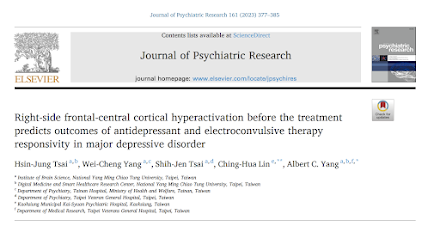Out on PubMed, from investigators in Taiwan, is this study:
Right-side frontal-central cortical hyperactivation before the treatment predicts outcomes of antidepressant and electroconvulsive therapy responsivity in major depressive disorder.
Tsai HJ, Yang WC, Tsai SJ, Lin CH, Yang AC.J Psychiatr Res. 2023 Mar 14;161:377-385. doi: 10.1016/j.jpsychires.2023.03.023. Online ahead of print.PMID: 37012197
The abstract is copied below:
Major depressive disorder places a great burden on healthcare resources worldwide. Antidepressants are the first-line treatment for major depressive disorder, but if patients don't respond adequately, brain stimulation therapy may be needed as second-line treatment. Digital phenotyping in patients with major depressive disorder will aid in the timely prediction of treatment effectiveness.
This study explored electroencephalographic (EEG) signatures that diversify depression treatment responsivity, including antidepressant administration or brain stimulation therapy. Resting-state, pre-treatment EEG sequences from depressive patients who received fluoxetine treatment (n = 55; 26 remitters and 29 poor responders) or electroconvulsive therapy (ECT, n = 58; 36 remitters and 22 nonremitters) were recorded on 19 channels. Twenty-nine EEG segments were obtained from each patient per recording electrode. Power spectral analysis was conducted for feature extraction and showed the highest predictive accuracy for fluoxetine or ECT outcomes. Both occurred with beta-band oscillations within right-side frontal-central (F1-score = 0.9437) or prefrontal areas of the brain (F1-score = 0.9416), respectively.
Significantly higher beta-band power was observed among patients who lacked adequate treatment response than the remitters, specifically at 19.2 Hz or 24.5 Hz for fluoxetine administration or ECT outcome, respectively. Our findings indicated that pre-treatment, right-side cortical hyperactivation is associated with poor outcomes of antidepressant-based or ECT-based treatment in major depression. Whether depression treatment response rates can be improved by reducing the high-frequency EEG power in corresponding areas of the brain to provide a protective effect against depression recurrence warrants further study.
Keywords: Cortical oscillation; Electroencephalogram; Machine learning; Precision psychiatry; Spectral analysis.
And from the text:
This is an interesting study using scalp EEG and sophisticated machine learning methods. It would be great if baseline EEG signature actually predicted treatment (both antidepressant medication and ECT) response. Would that it were a simple matter of reducing right hemisphere beta power to relieve depression, or is that like trying to make a car new again by rolling back the odometer on a treadmill?
Of course, the first step would be replication, and, unfortunately, that is unlikely to happen. Kudos to our taiwanese colleagues for this fascinating contribution to the ECT EEG literature.







Comments
Post a Comment